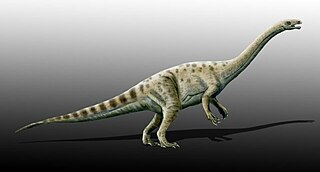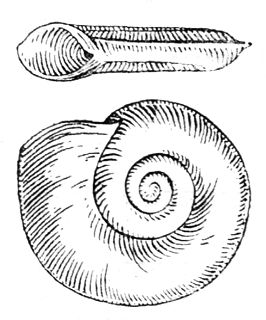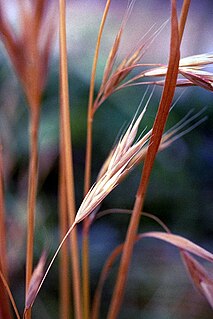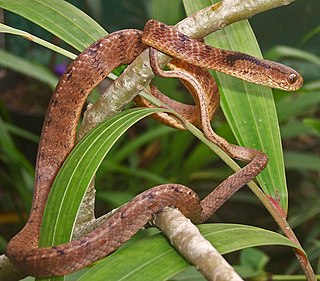Related Research Articles

Echis carinatus is a venomous viper species found in parts of the Middle East and Central Asia, and especially the Indian subcontinent. It is the smallest member of the big four snakes that are responsible for causing the most snakebite cases and deaths, due to various factors including their frequent occurrence in highly populated regions, and their inconspicuous nature. Five subspecies are currently recognized, including the nominate subspecies described here.

Massospondylus is a genus of sauropodomorph dinosaur from the Early Jurassic Period. It was described by Sir Richard Owen in 1854 from remains discovered in South Africa, and is thus one of the first dinosaurs to have been named. Fossils have since been found at other locations in South Africa, Lesotho, and Zimbabwe. Material from Arizona's Kayenta Formation, India, and Argentina has been assigned to this genus at various times, but the Arizonan and Argentinian material are now assigned to other genera.
Gryponyx is an extinct genus of massopod sauropodomorph known from southern Free State, central South Africa.

Plateosauridae is a family of plateosaurian sauropodomorphs from the Late Triassic of Europe, Greenland, Africa and Asia. Although several dinosaurs have been classified as plateosaurids over the years, the family Plateosauridae is now restricted to Plateosaurus, Yimenosaurus, Euskelosaurus, and Issi. In another study, Yates (2003) sunk Sellosaurus into Plateosaurus.

The razor-backed musk turtle is a species of turtle in the family Kinosternidae. The species is native to the southern United States. There are no subspecies that are recognized as being valid.
Echis carinatus astolae is a venomous viper subspecies endemic to Astola Island off the coast of Pakistan.

Massospondylidae is a family of early massopod dinosaurs that existed in Asia, Africa, North America, South America and Antarctica during the Late Triassic to the Early Jurassic periods. Several dinosaurs have been classified as massospondylids over the years. The largest cladistic analysis of early sauropodomorphs, which was presented by Apaldetti and colleagues in November 2011, found Adeopapposaurus, Coloradisaurus, Glacialisaurus, Massospondylus, Leyesaurus and Lufengosaurus to be massospondylids. This result supports many previous analyses that tested fewer taxa. However, this analysis found the two recently described North American massopods, Sarahsaurus and Seitaad, and the South African Ignavusaurus to nest outside Massospondylidae, as opposed to some provisional proposals. Earlier in 2011, Pradhania, a sauropodomorph from India, was tested for the first time in a large cladistic analysis and was found to be a relatively basal massospondylid. Mussaurus and Xixiposaurus may also be included within Massospondylidae. In 2019, a specimen previously assigned to Massospondylus from South Africa was re-examined and found to belong to a separate genus that was named Ngwevu.

Planorbis carinatus is species of air-breathing freshwater snail, a pulmonate gastropod mollusk in the family Planorbidae, the ramshorn snails.

Leiocephalus carinatus, commonly known as the northern curly-tailed lizard or saw-scaled curlytail, is a species of lizard in the family Leiocephalidae.

Bromus carinatus is a species of brome grass known by the common names California brome and mountain brome.
Copelatus carinatus is a species of diving beetle. It is part of the genus Copelatus of the subfamily Copelatinae in the family Dytiscidae. It was described by Sharp in 1882.

The keeled slug-eating snake, Pareas carinatus, is a species of snake in the family Pareidae. It is relatively widespread in Southeast Asia, from southern China (Yunnan) to Burma and Indochina to the Malay Archipelago. Two subspecies are recognized: P. c. carinatus and P. c. unicolor, the latter being confined to Cambodia.

Streptanthus carinatus, the lyreleaf jewelflower, is an annual to biennial plant in the mustard family (Brassicaceae) found in the Arizona Upland of the Sonoran Desert. Subspecies S. carinatus arixonicus has white to cream colored flowers in its western range, becoming strongly yellow eastward. Subspecies S. carinatus carinatus has purple flowers.
Esamirim is a genus of longhorn beetles of the subfamily Lamiinae, containing the following species:
Esamirim chionides is a species of beetle in the family Cerambycidae. It was described by Bates in 1885. It is known from Panama and Costa Rica.
Esamirim divisus is a species of beetle in the family Cerambycidae. It was described by Martins and Galileo in 2004. It is known from Panama.
Esamirim fasciatus is a species of beetle in the family Cerambycidae. It was described by Martins and Galileo in 2004. It is known from Costa Rica.
The comb-spined catfish is a species of catfish in the family Ariidae. It was described by Max Carl Wilhelm Weber in 1913, originally under the genus Arius. It is known to inhabit freshwater rivers in New Guinea. It reaches a standard length of 40 cm (16 in). Its diet includes prawns, detritus, and a variety of terrestrial and aquatic insects and insect larvae.

Ngwevu is a genus of massospondylid sauropodomorph dinosaur from the Lower Jurassic Elliot Formation of South Africa. The type and only known specimen, BP/1/4779, was discovered in 1978 by James William Kitching. It had in 1990 and 2004 been regarded as an unusual specimen of the related Massospondylus, with a horizontally and vertically compressed skull, but in 2019 the specimen was after restudy concluded to belong to a new distinct genus. The genus is primarily distinguished by its skull being more robust than that of Massospondylus.

Collatus is a genus of very small and minute sea snails with an operculum, marine gastropod mollusks in the family Vitrinellidae.
References
- ↑ BioLib.cz - Esamirim carinatus. Retrieved on 8 September 2014.